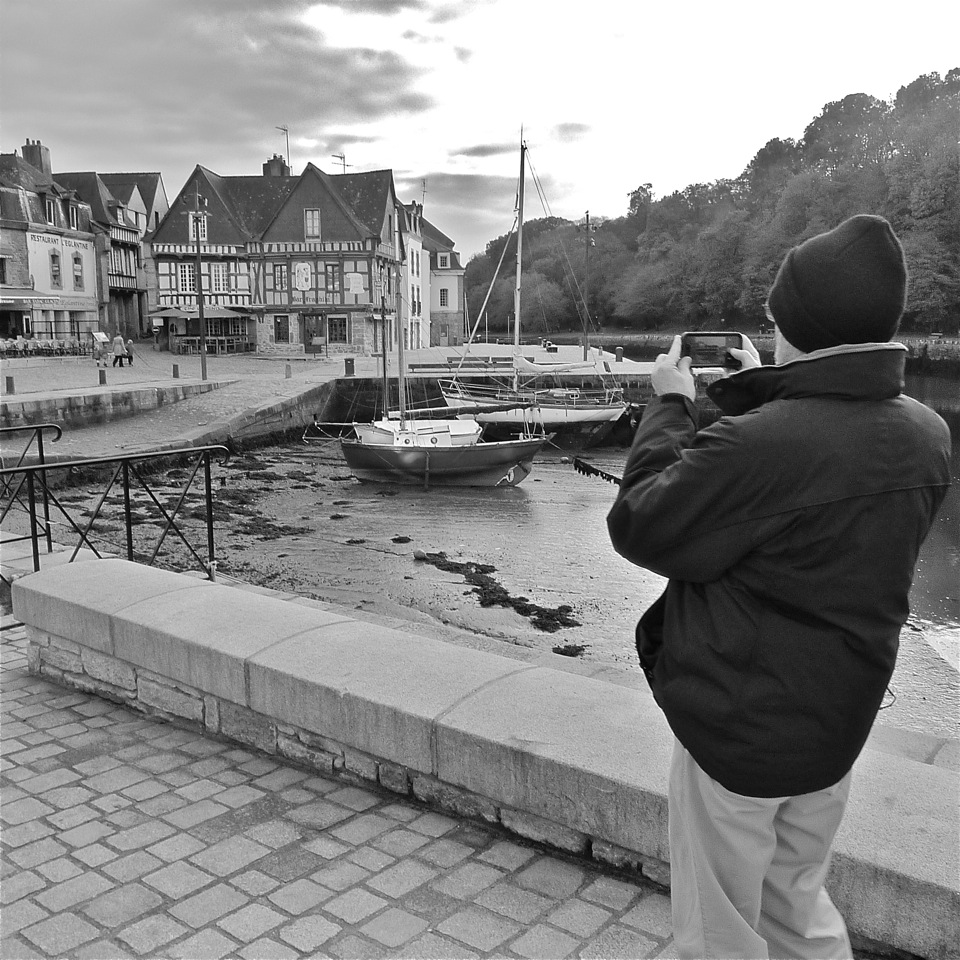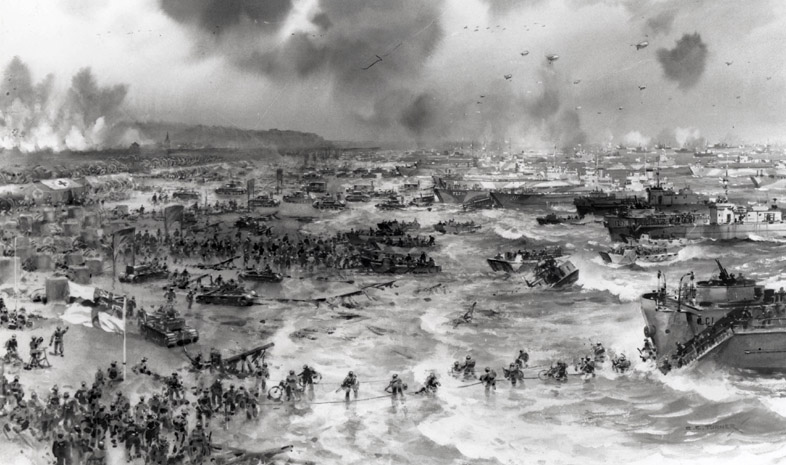Uncategorized
27. Larry Wells' Salute to D-Day 70th Anniversary
Tomorrow is the 70th anniversary of D-Day. HottyToddy.com contributing writer Larry Wells has written a moving piece on his own travels to the beaches of Normandy. the article was first published by Historical Travel Magazine.
UTAH BEACH IS THE PLACE to be on a warm afternoon in Normandy. Couples pushing baby carriages stroll the beaches at low tide under the marbled gaze of La Vierge Noir, a statue of the Madonna and Child.
The only evidence of the battle which took place here are a few concrete and steel German bunkers hunkered among the sand dunes, scarred by bullets and graffiti.
A wind surfer with wheels attached to his surfboard glides along the beach. Riding the breeze with élan he careens onto the salt flats and wipes out on the wet sand. Out of nowhere a thoroughbred trotting horse emerges from the dunes pulling a cart fitted with automobile tires. A beachcomber explains that the trainers like to work their horses in the sand because it is easy on their hooves. The district of Manche, on the eastern side of the Cotentin peninsula, is horse country. Normans take racing every bit as seriously as Kentuckians or Marylanders.
Yet lying beneath the sound of children’s laughter and dogs barking and the soft crash of breakers is the palpable presence of history. This is where Brig. Gen. Theodore Roosevelt, Jr., of 4th Division, VIIth Corps, led 30,000 soldiers and 3,500 vehicles ashore on D-Day, June 6, 1944. Thanks to strong lateral currents which pushed the landing boats some 4,000 yards farther to the east than planned, VIIth Corps encountered minimal resistance from German defenders.
Sensing his advantage Roosevelt proceeded to land at the “wrong place.” Utah Beach turned out to be an island of calm compared to Omaha Beach, 15 miles to the east. At Bloody Omaha, as it came to be known, U.S. assault troops suffered 41% casualties of 14,000, including approximately 3,000 dead. Near where the VIIth Corps landed on Utah Beach there is a little piece of America. Surrounding a red granite monument is a 50 x 50 foot square of United States territory, ceded to America in 1984 by the French government, the down payment made by GIs.
The rugged coastline in this part of Normandy alternates between sandy beaches, whose tidal flats are a half mile wide at low tide, and sheer cliffs to the north. The beaches remain relatively free of real estate development. Cold winters keep most vacationers away until summertime, when Parisians flock here on weekends.
A clothesline extends from a German WWII bunker in the dunes, red and yellow beach towels and bathing suits hung out to dry. A French family is camping out in the bunker. Where German soldiers once stood vigil, a little boy’s smiling face appears at a menacing machine gun slit, nonchalantly taking possession of what once was a battlefield as if to say, “We came, we camped, we conquered, n’est ce pas?”
Almost every turn in the road reveals a WWII battle site, a skirmish won or lost, a village liberated. Not far from Utah Beach the villagers of St. Marie du Mont have commemorated their liberation with a series of historical markers. One of them relates the curious story of a house painter who was relieving himself, while two German officers standing on a nearby balcony studied a map of Atlantic Wall defenses. The map blew away in the wind and landed beside the painter, who alertly stuffed it in his pocket.
When the Germans demanded to know if he had seen a piece of paper he shook his head and said, “Non.” Later, he delivered the map to the French Underground.
Similar tales of individual heroics pop up in the bocage country like narcissus in springtime. Every family can tell them by the dozen, usually over a bottle of Calvados, the formidable apple brandy of Normandy.
Less than ten miles inland from Utah Beach is the town of Sainte Mere Eglise, arguably the most famous site in Normandy. The movie The Longest Day, based on Cornelius Ryan’s best-selling book and filmed in St. Mere Eglise in 1961, helped establish this rural town (population 1,564) as a symbol of the liberation of France. Kilometer 00 of the “Liberty Highway” of 1944 begins on the town square.
St. Mere Eglise has not been shy about showcasing its claim to fame. Street names keep victory shining on every corner: Rue de 505eme Airborne, Place du 6 Juin, Rue Gal. Gavin, Rue Gal. Eisenhower. There is even a hotel named for John Steele. (It might just as aptly be called “Hotel Red Buttons”). Only the French with their instinctive appreciation of the absurd would confer deathless fame on a soldier who played dead.
An American flag flies permanently alongside the French tricolor on the town square. “AA” stickers abound on rear windows of Renaults and Citroens plying the busy streets, signifying the “All American” (82nd Airborne) Division, so named because during World War One it had soldiers from all 48 states.
In the Dakota Cafe, whose speciality is mutton stew famous for its salty flavor (ocean breezes deposit salt on the pastures)the men and women playing cards at a table are curious about a white-haired American tourist with a military bearing. After a while, one of them approaches his table and asks timidly, “Airborne?” Flattered by the attention, he admits that, yes, he was a paratrooper in the 82nd Airborne when it liberated St. Mere Eglise over fifty years ago. Instantly the townspeople crowd around his table asking him to autograph the backs of receipts, menus, napkins, any scrap of paper they can lay their hands on.
Yet even amid such unabashed Yankee-philia it comes as a surprise to see a camouflage parachute and a dummy paratrooper hanging from the roof of the medieval church in the town square. There is also an “82nd and 101st Airborne Museum” founded by Philip Jutras, a WWII vet from Maine. “Every year just after Easter, they put out the dummy paratrooper,” Jutras tells me. “They never forget what America did for them. There isn’t another town in France where Americans are more welcome or more revered.”
In addition to housing a C-47 airplane which flew missions over Normandy, a glider, artillery pieces and an armored half-track, the museum displays many personal items collected from veterans: letters from GIs, K-rations, sidearms, French-English dictionaries, shaving cream containers, a Bible that was traced to a Pawnee Indian soldier from Oklahoma. The roof of the museum has been fashioned, not unexpectedly, in the shape of Sainte Mere Eglise’s icon, a parachute.
On sale at the museum are replicas of the famous “cricket” the paratroopers used to signal each other in the dark. John Wayne, who played Lt. Col. Benjamin Vandervoort in The Longest Day, clicked the gadget to his men at a pre-invasion briefing and waiting for them to click twice in response, then yelling “Do you read me?” In fact it is impossible to visit Sainte Mere Eglise without recalling scenes from The Longest Day. (If the town has a patron saint it must be Cornelius Ryan.) Is there a moviegoer who does not know the story? In the early hours of June 6, 1944, a house near the town square caught fire. Mayor Alexandre Renaud organized a bucket brigade to fight the blaze while German soldiers with machine guns looked on. As the citizens passed buckets to and from a communal well, their faces suddenly turned up towards the sky where paratroopers began falling like rain.
“Just at that moment,” Mayor Renaud wrote later in his war memoir Sainte Mere Eglise, “a big transport plane, all lights ablaze, flew right over the tree-tops, followed immediately by others, and yet others. They came from the west in great waves, almost silent, their giant shadows covering the earth. Suddenly, what looked like huge confetti dropped out of their fuselages and fell quickly to earth. Paratroopers!”

Larry Wells takes a picture in a French coastal town near the D-Day beaches lat November. Photo by Alain Desvergnes.
French civilians fled indoors as the battle raged through the streets. By 4:30 a.m. the Germans had been driven out of Sainte Mere Eglise by the Third Battalion, 505th Regiment, 82nd Airborne. The battalion commander, LTC. Edward C. Krause, raised his unit’s colors in front of the town hall, where an American flag is kept on permanent display.
Mayor Renaud’s son, Henri Jean Renaud, operates a pharmacy in the same location as that of his father. Monsieur Renaud speaks of D-Day respectfully as if the past were a worn letter that could fall apart in his hands.
“I was here when the paratroopers came,” he recalls. “I could see them, the soldiers, coming down in the night. We heard shouting but we were not afraid, my brother and I, because we were excited that the Americans were coming. Every night for a week my father had made us sleep with our clothes on and suitcases packed. We knew something was about to happen and now it was happening. A big shell exploded near the house and I couldn’t see my parents. I started to cry, then. The next day my father took me to see a paratrooper hanging from a tree. I had never seen a dead man before and I touched his boot. He began to turn around slowly in the air.”
The boys and girls of 1944, now growing old, have not forgotten their delight at treasure that fell from the sky. They dragged machine guns home, or broken radios, or canteens filled with British water, or helmets from both armies bayonets, epaulettes, insignia, caps, pants and blouses a never-ending bonanza. Crashed gliders rested in the fields by the hundreds. Parachutes covered the grass like a giant silk curtain. That silk later would become burial shrouds for 10,000 American soldiers temporarily buried around Sainte Mere Eglise, and still later silk dresses for the girls.
“Let me show you something!” Renaud leads me to an attic above his shop. The last part of the ascent is like climbing the rungs of time. In the cramped storeroom at the top, the air is close and still. On the floor, arranged helter-skelter by a boy’s hand, are war souvenirs that for more than half a century have remained undisturbed: German and American helmets, parachutes, weapons, mess kits, all covered with thick dust. When I suggest that he could start a private museum with such trophies, Renaud replies, “I would not want to see these things all neat and tidy on a shelf. I would rather they stay here, out of sight, in the place where I put them myself. It is the dust of history, you know?”
Standing in the family shrine, examining items he last touched years ago, Renaud’s eyes dart restlessly as he seeks to express what happened to his town, his family, himself. His gaze settles on a green parachute in a cardboard box. “Other towns were liberated by the American infantry as they marched inland,” he said, “but freedom came to Sainte Mere Eglise from the sky.”
Lawrence Wells is the author of the WWII novel Rommel and the Rebel. Wells has written three novels and edited six non-fiction books including William Faulkner: The Cofield Collection. With his wife Dean Faulkner Wells, he operated Yoknapatawpha Press, an independent press in Oxford, Mississippi, and co-published a quarterly journal, The Faulkner Newsletter. Co-founder of the Faux Faulkner Contest, he also scripted an Emmy-winning PBS regional documentary, “Return to the River.” He has been a frequent contributor to American Way and Southwest Spirit magazines and The New York Times Syndicate.





















You must be logged in to post a comment Login